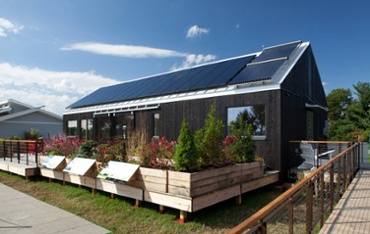
Super-Efficient Homes vs Code-Built Homes
6/20/2014
When building a new home, design and material selection greatly impact the operating costs for decades. Investing in triple-pane windows and doors, generous insulation, and air sealing can greatly reduce your heating and cooling costs, while also boosting comfort. Is it financially savvy to construct a super efficient home over a code-built home because of the reduction in operating costs?
The simple answer is yes, but the more detailed answer is that it depends. Some energy efficient upgrades have a lot of bang for your buck, while others don’t. Your local climate is another variable.
Tessa Smith, co-owner of the Artisan Group in Olympia, Washington says the payback period of upgrading a home to an ultra-energy-efficient home over a code-built house can be a mere five years or less in the Pacific Northwest, with the upfront construction costs being four to six percent higher. Super-efficient homes require an investment in different materials and mechanical systems, some increasing and others decreasing the construction costs. Mechanical ventilation, more efficient hot water heating, upgraded windows and doors, and more insulation add to the cost, while money is saved on the heating and cooling system, according to Smith.
Super-efficient homes with air sealing require mechanical ventilation to circulate outside air, bringing in a fresh stream of filtered air and preventing mold issues. Such homes typically don’t use combustion fuels, such as natural gas furnaces and propane stoves, because the byproducts contaminate the indoor air quality. Airtight homes with air sealing allow very little air into the home, thus fresh air is brought in with a ventilation system that recycles heat.
All 36 homes at Belfast Cohousing & Ecovillage (BCE) in Midcoast Maine have Zehnder heat recovery ventilation (HRV) system, that transfer 90% of the heat from the exhaust air to the intake air before it exits the home. Stale air is removed from the kitchen and bathrooms and fresh air is supplied to the bedrooms.
“Air sealing a building prevents the air you have paid to condition from leaving the building — but it also prevents air that may be filled with contaminants from entering uncontrollably,” says Adam Romano, Director of Training Operations at the Association for Energy Affordability. “Combining air sealing with proper ventilation, such as Heat Recovery or Enthalpy Recovery Ventilation systems (HRV/ERV) will provide control over where you extract the contaminants produced in your home, how you treat incoming air to remove external contaminants, and how you optimally distribute this fresh air into living spaces.”
Although a high-efficiency HRV system for a house may cost more than exhaust-only ventilation, it is a necessary fixture in high-efficiency homes and reduces the operating costs by allowing a higher level of energy efficiency that would otherwise result in poor indoor air quality and moisture issues without mechanical ventilation. A typical code-built house exchanges air into and out of the home through leaks, exhaust fans, and mechanical systems, although this is very inefficient when it is cold outside because the heat isn’t captured before leaving the home. The HRV system helps make it possible to remove a much costlier and less efficient furnace or boiler by very efficiently heating intake air with recycled heat from the exhaust air.
“These houses [at BCE] are so tight that you can control what air comes in through one little pipe,” explains Brian Hughes, a carpenter for GO Logic and member of BCE. “Then you can use a heat exchanger to take almost all the energy out of the exhaust air [before it exits the home].”
Many high-efficiency homes have no boiler, furnace, or air conditioners, as simple electric baseboard heaters can sufficiently and economically heat the home because the heat loss of the home is so modest, even in a cold climate like Maine. “Because the heat loads of the buildings [at BCE] are so low, it really doesn’t argue for anything but the cheapest heating system you can get, which is electric resistance baseboard heat,” says Alan Gibson, principal of GO Logic, the design-build company that worked with BCE members to design and construct the community. “We saved a lot of money there.”
Gibson estimates that replacing the heating system with electric baseboard heaters saves $15,000 in the 1,500-square-foot homes. Other energy-efficiency components boost the construction costs, including air sealing, a high-efficiency heat recovery ventilation system, improved insulation, and triple-pane windows and doors. The result is a 7 percent increase in construction costs, with a seven and a half year payback period from the energy savings.
These energy efficiency upgrades result in a 90 percent reduction in energy for space heating compared to the average house, yielding much lower heating bills. Gibson estimates a 1,500-square-foot BCE home uses $300 to heat using electric baseboard heat, while a standard Maine home costs over $2,500 to heat with an estimated 680 gallons of oil. In addition, the homes stay cool in the summer without needing air conditioning. If these ultra-efficient homes are purchased using a mortgage, it results in lower annual bills (a higher mortgage offset by lower electric bill), thus having an instant payback.
“Increasing building performance has a multitude of benefits,” adds Romano. “The associated fuel savings and lower operating costs, are obvious; others take a little longer to show themselves, but can be more dramatic. What value would you put on decreasing the frequency or intensity of your child’s asthma attacks, reducing hospitalizations and missed school days? Direct health benefits flow from increasing your home’s energy efficiency, many resulting from improved indoor air quality.”
——–
Sarah Lozanova is a regular contributor to environmental and energy publications and websites, including Mother Earth Living, Green Building & Design, Triple Pundit, Urban Farm, and Solar Today. Her experience includes work with small-scale solar energy installations and utility-scale wind farms. She earned an MBA in sustainable management from the Presidio Graduate School and she resides in Belfast Cohousing & Ecovillage in Midcoast Maine with her husband and two children.
